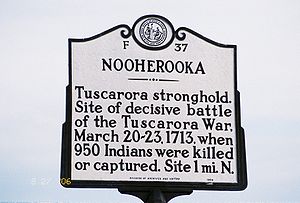
Fort Neoheroka
Encyclopedia

Greene County, North Carolina
-Demographics:As of the census of 2000, there were 18,974 people, 6,696 households, and 4,955 families residing in the county. The population density was 72 people per square mile . There were 7,368 housing units at an average density of 28 per square mile...
, North Carolina
North Carolina
North Carolina is a state located in the southeastern United States. The state borders South Carolina and Georgia to the south, Tennessee to the west and Virginia to the north. North Carolina contains 100 counties. Its capital is Raleigh, and its largest city is Charlotte...
by the Tuscarora
Tuscarora (tribe)
The Tuscarora are a Native American people of the Iroquoian-language family, with members in New York, Canada, and North Carolina...
tribe during the Tuscarora War
Tuscarora War
The Tuscarora War was fought in North Carolina during the autumn of 1711 until 11 February 1715 between the British, Dutch, and German settlers and the Tuscarora Native Americans. A treaty was signed in 1715....
of 1711-1715. In March of 1713, the fort was besieged and ultimately attacked by a colonial
Thirteen Colonies
The Thirteen Colonies were English and later British colonies established on the Atlantic coast of North America between 1607 and 1733. They declared their independence in the American Revolution and formed the United States of America...
force consisting of an army from the neighboring Province of South Carolina
Province of South Carolina
The South Carolina Colony, or Province of South Carolina, was originally part of the Province of Carolina, which was chartered in 1663. The colony later became the U.S. state of South Carolina....
, under the command of Colonel James Moore and made up mainly of Indians
Native Americans in the United States
Native Americans in the United States are the indigenous peoples in North America within the boundaries of the present-day continental United States, parts of Alaska, and the island state of Hawaii. They are composed of numerous, distinct tribes, states, and ethnic groups, many of which survive as...
including Yamasee
Yamasee
The Yamasee were a multiethnic confederation of Native Americans that lived in the coastal region of present-day northern coastal Georgia near the Savannah River and later in northeastern Florida.-History:...
, Apalachee
Apalachee
The Apalachee are a Native American people who historically lived in the Florida Panhandle, and now live primarily in the U.S. state of Louisiana. Their historical territory was known to the Spanish colonists as the Apalachee Province...
, Catawba
Catawba
Catawba may refer to several things:*Catawba , a Native American tribe*Catawban languages-Botany:*Catalpa, a genus of trees, based on the name used by the Catawba and other Native American tribes*Catawba , a variety of grape...
, Cherokee
Cherokee
The Cherokee are a Native American people historically settled in the Southeastern United States . Linguistically, they are part of the Iroquoian language family...
, and many others. The 1713 siege lasted for more than three weeks, from around March 1 to March 22, 1713. Hundreds of men, women and children were burned to death in a fire that destroyed the fort. Approximately 170 more were killed outside the fort while approximately 400 were taken to South Carolina where they were sold into slavery. The defeat of the Tuscaroras, once the most powerful indigenous
Indigenous peoples
Indigenous peoples are ethnic groups that are defined as indigenous according to one of the various definitions of the term, there is no universally accepted definition but most of which carry connotations of being the "original inhabitants" of a territory....
nation in the North Carolina Territory
Province of North Carolina
The Province of North Carolina was originally part of the Province of Carolina in British America, which was chartered by eight Lords Proprietor. The province later became the U.S. states of North Carolina and Tennessee....
, opened up North Carolina’s interior to further expansion by European settlers
European colonization of the Americas
The start of the European colonization of the Americas is typically dated to 1492. The first Europeans to reach the Americas were the Vikings during the 11th century, who established several colonies in Greenland and one short-lived settlement in present day Newfoundland...
. The supremacy of the Tuscaroras in the state was broken forever. Most moved north to live among the Iroquois
Iroquois
The Iroquois , also known as the Haudenosaunee or the "People of the Longhouse", are an association of several tribes of indigenous people of North America...
. On July 17, 2009, the Fort Neoheroka Site was added to the National Register of Historic Places
National Register of Historic Places
The National Register of Historic Places is the United States government's official list of districts, sites, buildings, structures, and objects deemed worthy of preservation...
.
See also
- Colonial history of the United States
- History of North CarolinaHistory of North CarolinaThe history of North Carolina from prehistory to the present covers the experiences of the people who have lived in the territory that now comprises the U.S. state of North Carolina....
- National Register of Historic Places listings in North Carolina
External links
- Fort Neoheroka Excavation and Artifacts, tuscaroras.com

